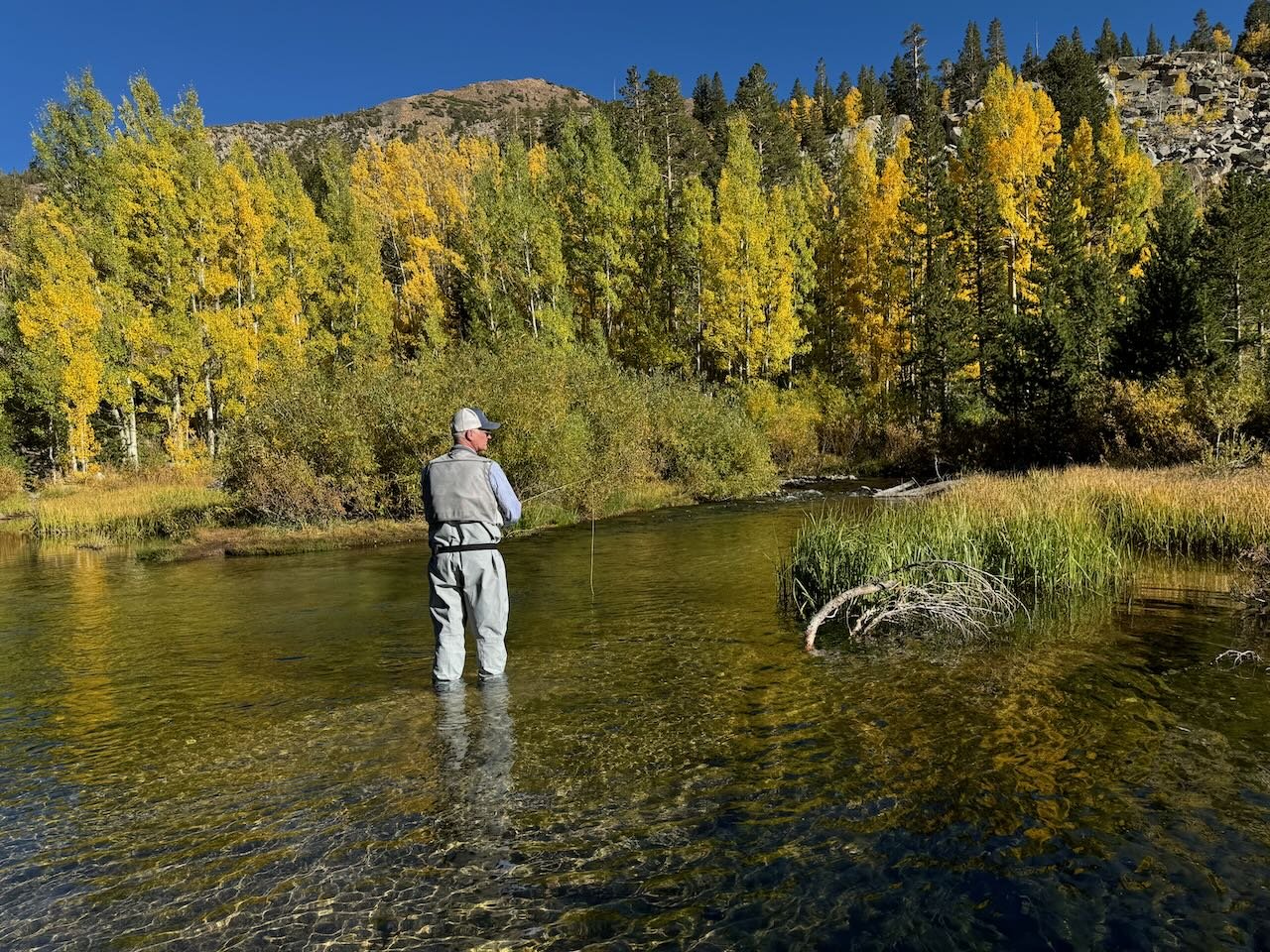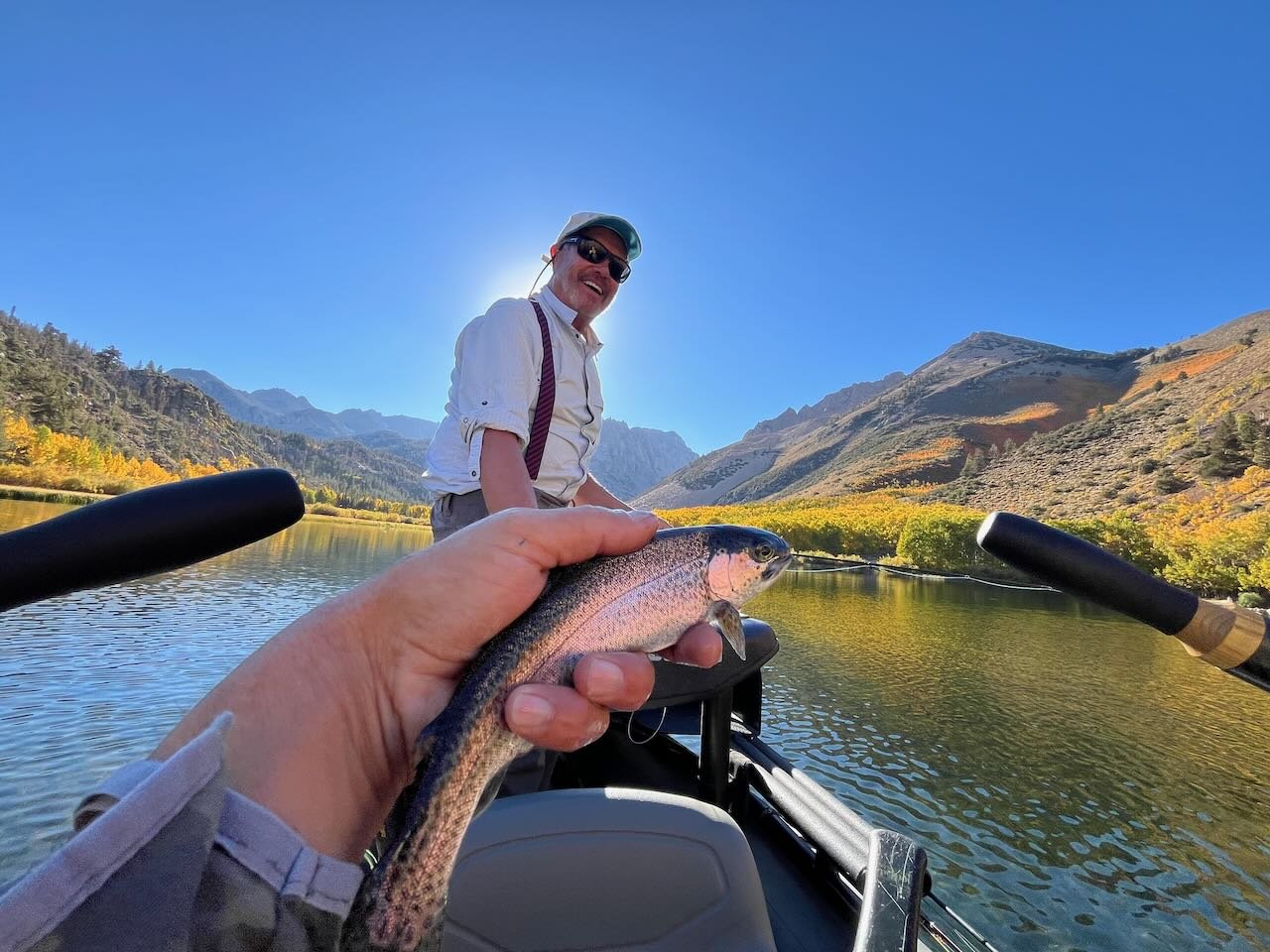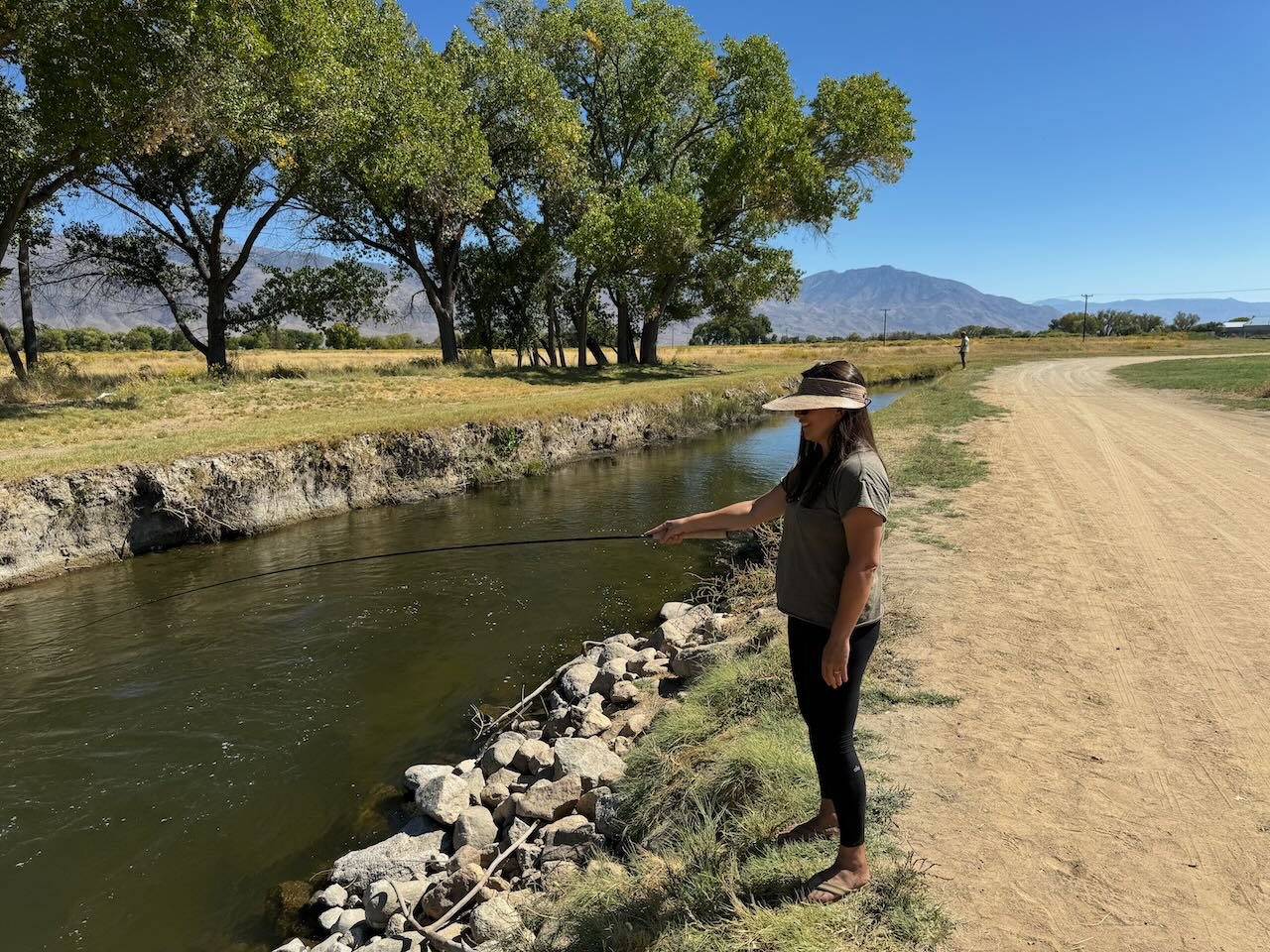Hard to believe that October is here. Cool mornings, warm days and cool nights is the perfect fall weather. Fall colors is the perfect backdrop to fly fishing high country creeks and lakes. Fall colors are peaking at upper elevation waters you can drive to. Dry flies, nymphs and streamers are producing trout. This is the perfect time to be throwing large articulated streamers. Big fish need to eat and big streamers offer them a big meal. Midges, caddis flies and mayflies are hatching and the trout are feeding on the nymphs and the adults. This is the middle of SeptOct and now is the time to be out flyfishing in the Eastern Sierra. Winter is not far off on the horizon.
Fall colors make for the perfect back drop for fly fishers fishing ponds, lakes and creeks at upper elevations.
Hot Creek
Interpretive Site:
When the word gets out that Hot Creek is producing trout fly fishers line up on the banks of the creek. Mornings start off with a caddis migration. The caddis are flying upstream and any caddis that end up on the water is being fed on by the trout on the surface. The trico hatch is coming off no later than 9:00 A.M. It starts with the trico dun hatching. Fish with a size 22 trico dun parachute or female trico dun parachute. Switch to a trico spinner when the trout are not taking your dun pattern. With the deeper holes in the Interpretive Site fish with nymphs under an indicator or with a Euro rig. Nymph with size 18 olive quilldigons, size 18 bead head flash back pheasant tail nymphs, size 16 hot spot pheasant tail nymphs, size 18 Frenchie’s and size 18 SOS nymph.
Four guides and 15 fly fishers made for a crowded Interpretive site fly fishing during the morning trico mayfly hatch.
Hot Creek
Canyon Section:
With the weed beds still inhibiting the drifts now is the perfect time for a dry and dropper rig. Stimulators in size 12 and 14, Adams parachutes in size 16 and elk hair caddis in size 16 make for good dry flies in the dry fly part of the dry and dropper rig. For nymphs fish with size 18 olive quilldigons, size 18 bead head flash back pheasant tail nymphs, size 18 Frenchie’s and size 16 hot spot pheasant tail nymphs. When the trout are keying in on the hatching adults cut off the nymph and add a size 20 blue wing olive parachute, size 22 trico parachute, size 22 trico spinner and a size 20 gray parachute caddis to imitate the hatching insects.
Float tubers have to paddle up the lake from their launch spot to get to the shallow waters that are holding trout by the inlet of the Owens River into Crowley Lake.
Crowley Lake
Mouth of the Owens River:
The shallows near the inlet of the Owens River into Crowley Lake is where you will find the flotilla of fly fishers concentrating their efforts. These fly fishers are fishing in the 10 foot zone with Albino Barron’s, gray midges, blood midges, zebra midges and tiger midges under a sliding indicator pinned with a bopper stop. Afternoon winds blows most anglers off the lake by noon. This is the time of year to be imitating the perch fry with size 8 olive matukas, size 10 perch balanced leeches and size 10 olive wooly buggers.
Jim Arce from Tiburon is skating stimulators in the evening trying to entice a trophy trout to come to the surface.
Upper Owens River
Above Benton Crossing Bridge:
For fly fishers who know how to get a drag free drift with the right fly pattern are producing trout from three inches to 12 inches. Trophy trout are not in the river yet in any kind of concentration. Working nymphs like a size 18 olive quilldigon, size 16 hot spot pheasant tail nymph, size 12 stoner nymph and size 12 green/gold wire prince nymph in the deep holes, deep runs and cutbanks are producing a few trophy rainbows and browns. Successful anglers are covering lots of water to get one or two trophy trout. Fly fishers working streamers are producing trout. An olive wooly bugger in size 10, an olive matuka in size 8 and a black marabou muddler in size 8 are producing rainbows and browns. Nymphing with size 18 bead head flash back pheasant tail nymphs, size 18 olive quilldigons, size 16 bead head flash back pheasant tail nymphs and size 16 SOS nymphs are fooling the non-trophy trout. These trout are also feeding on the surface and size 16 elk hair caddis, size 18 blue wing olive parachutes, size 22 trico parachutes and size 22 Griffith’s gnats are fooling the surface feeding trout.
Mark Sachs from San Rafael with a stocked rainbow he caught while fly fishing from Richard Lancaster' s Stealth Craft drift boat on North Lake.
North Lake:
Float tubing the inlet to North lake with a dry and dropper rig is producing wild brown trout and stocked rainbow trout. For the dry fly in the rig fish with a size 14 olive stimulator, size 16 Adams Parachute or a size 16 elk hair caddis. For the nymphs use size 18 or 20 tiger midges, zebra midges, size 18 bead head flash back pheasant tail nymphs and size 16 bead head flash back gold ribbed hare’s ears. For the hardy angler willing to walk out to the inlet there is good fly fishing from the shore.
Weir Pond dressed in its fall colors produced rainbow, browns and brook trout on a dry and dropper rig.
Bishop Creek
South Fork at Weir Pond:
Fall is a great time to be fly fishing in Bishop Canyon. The trees in their fall colors makes for the perfect backdrop for fly fishers working the ponds, lakes and creeks. A dry and dropper rig worked great in the late afternoon producing browns, rainbows and brook trout. A size 16 Adams parachute with a size 16 bead head flash back gold ribbed hare’s ear was the winning combination to produce all three species of trout in the pond. The evening hatch of midges, mayflies and caddis produced not stop action on nymphs and dries. Be prepared for the temperatures to drop once the sun goes behind the mountain tops.
Teaching Katy Sakamoto from Santa Monica to use her brand new Tenkara rod on Bishop Creek Canal where she missed several trout on a size 16 Adams parachute.
Bishop Creek Canal
Behind Bishop Veterinary Hospital:
Nymphing and dry fly fishing is producing wild brown trout on Bishop Creek Canal. An Adams parachute high sticked with a Tenkara rod fooled several wild browns to 10 inches. Nymphing under an indicator with a size 18 bead head flash back pheasant tail nymph and a size 16 bead head flash back gold ribbed hare’s ears six feet under an indicator with a size one split shot was the rig that’s been producing. This is a great water to Euro nymph with a Euro rod or Euro nymph with a Tenkara rod. Size 12 stoner nymphs, size 12 green/gold Prince nymphs, size 14 hot spot pheasant tail nymphs and size 18 olive quilldigons are fooling the wild brown trout and the occasional hatchery rainbow trout. I wore shorts to an evening outing on the canal not thinking that the mosquitoes would still be out in force. Fifteen to 20 bites latter and I was not a happy camper







